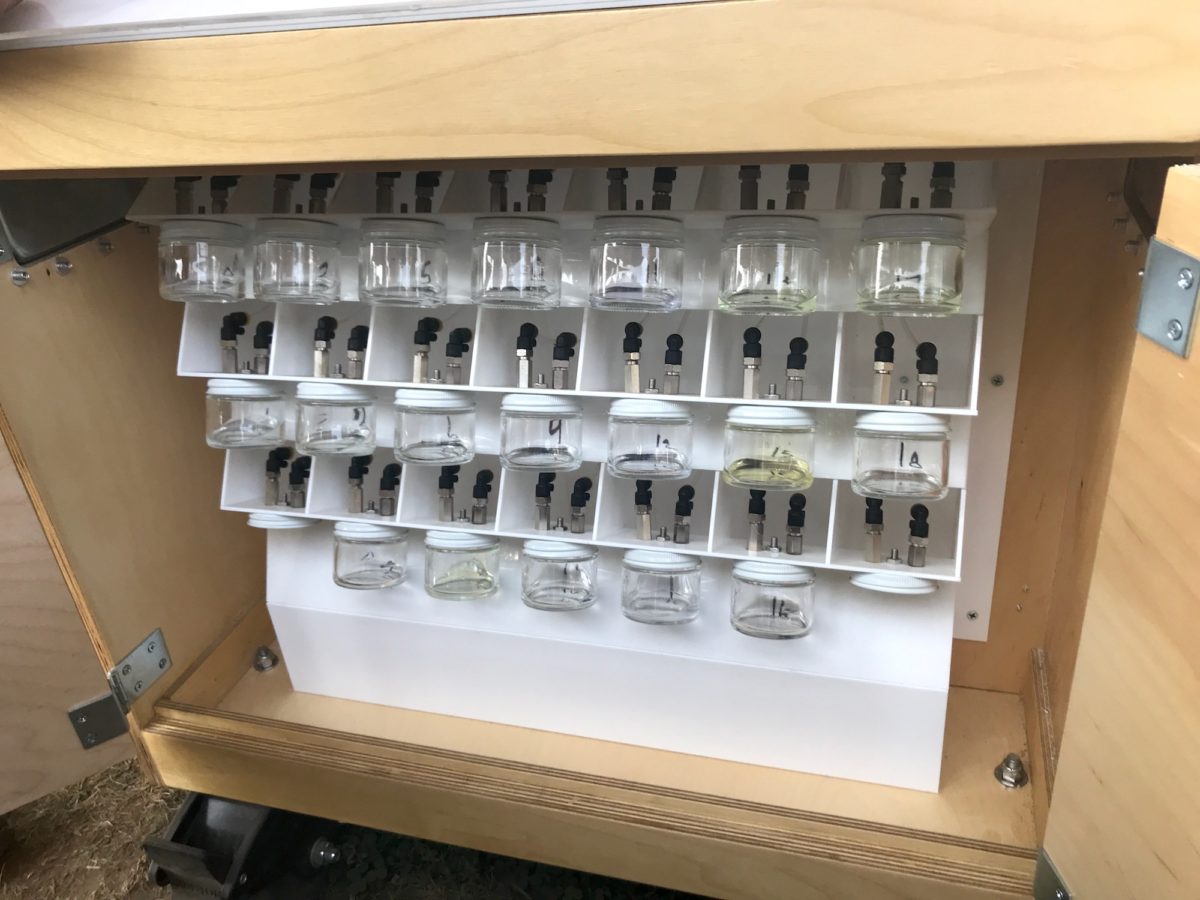Mix up some lavender, almond extract, ripe fruit and nail polish remover. What do you get? Apparently, a sweet cherry smell.
That’s just one possible scent combination out of more than 500,000 that can be served up by the Smell Synth, a machine that releases flavor compounds at the press of a button. It was on display this past weekend at the World Maker Faire 2017, which was held at the New York Hall of Science in Corona, Queens. As it turns out, the maker behind the Smell Synth is based here in Brooklyn: it’s from the Museum of Food and Drink (MOFAD), located in Williamsburg. It was originally part of MOFAD’s first exhibit from 2015, appropriately entitled Flavor.
Judging by what we saw, the Smell Synth proved to be pretty popular at Maker Faire.
Small groups of adults and children alike waited patiently in line to smell scents such as buttered popcorn, pancakes and orange soda. (Interestingly enough, quite a bit of nail polish remover — or more specifically, ethyl acetate, the chemical associated with it — was involved.) It also won two “editor’s choice” blue ribbons and three “best in class” red ribbons.
But don’t fret if you weren’t able to make the trek to Queens for the Maker Faire. The Smell Synth is still on display at the museum Friday through Sunday, from noon to 6 p.m.
MOFAD is also launching a new exhibit this weekend, Chow, on Chinese-American cuisine.
https://twitter.com/dalepd/status/911958219026784257
We had a chance to speak with one of the Smell Synth’s creators, Matthew Davis, who filled us in on the history of the machine. Davis is the cofounder of Common Kinetics, a design and mechanical engineering firm in Manhattan. He got involved with MOFAD after seeing another one of the museum’s maker projects, a cannon that fired rice puffs.
The museum’s cofounder, Dave Arnold, came up with the concept for another device that would allow visitors to explore the theme of Flavor, MOFAD’s first full exhibit. With the assistance of scientists from the Monell Chemical Senses Center in Philadelphia, Arnold developed the first version of the Smell Synth. (Popular Science covered the exhibit and the machine quite thoroughly.)
After that initial exhibit, the museum’s staff was interested in repurposing the machine, in order to make it portable — the original was wall-mounted — and to be able to change its content periodically. That’s where Davis and his business partner, Ziggy Drozdowski, came in. The two volunteered to revamp the Smell Synth in a space of just four weeks this past summer. The new machine made its debut at Summer Streets last month, before coming to Maker Faire last weekend.
Davis said he appreciates the chance to bring science education to the public in a novel way.
“Everyone can be an at-home scientist by cooking,” he said. “So it makes sense to bring this exhibit out to Maker Faire.”

Here’s how it works.
At the bottom of the machine is a rack that contains two-ounce jars of each flavor compound. In a separate compartment is an air compressor, which is connected to electrical valves for each scent. The valves are controlled by an Arduino microcontroller: when someone presses a button for a particular scent, the microcontroller prompts the corresponding valve to open and release the scent.
Users can smell the scents through one of two tubes attached to the machine. The Smell Synth also includes a vacuum system, which sucks scents back into the machine once they’re no longer activated, so that a clash of competing smells doesn’t build up as more and more people use the machine.
At Maker Faire, the Smell Synth featured the same array of scents as in the original Flavor exhibit. But in the future, Davis told Technical.ly, the museum plans to develop new education content involving other scents. The Smell Synth could enable visitors to experience the different aromas in a bottle of wine, for instance, or explore how certain spices are combined in different regional cuisines. A second Smell Synth is also in place at the Pacific Science Center in Seattle, as part of an exhibit about the link between smell and memory.
“This machine is designed to be a flexible platform for new ideas, different content,” he said. “It will have the same top-level building blocks of smell but allows us to focus it to different culinary areas.”







